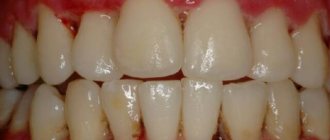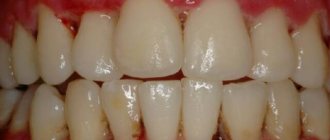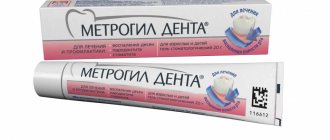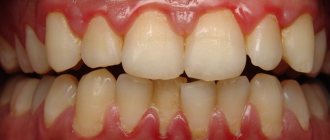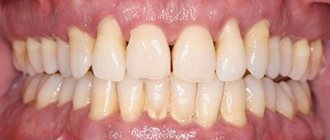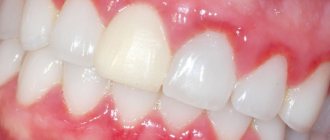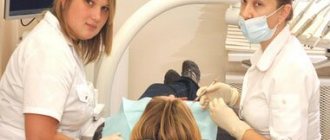Necrotizing ulcerative gingivitis, or Vincent's stomatitis, is a severe form of inflammatory gum disease, which is accompanied by necrosis of the periodontal tissues. It manifests itself as a complication of catarrhal gingivitis, is rare and cannot be cured without medical care.
Characteristic signs: painful gums, bleeding, ulcers with a whitish coating and a strong putrid odor from the mouth. More often, this pathology manifests itself in the winter-spring period and at a stressful time for a person. The sudden appearance of Vincent's gingivitis is one of the first signs of HIV infection.
Etiology
Pathogens
The cause of the development of necrotizing ulcerative gingivitis is a bacterial infection in the pathogenic microflora. The causative agents are anaerobic bacteria, spirochetes and fusobacteria.
“Flocks” of such pests live in the mouth of every healthy person, but their number is negligible and they are not dangerous.
If a person does not follow the rules of hygiene or his immunity weakens, anaerobic spirochetes and fusobacteria begin to actively multiply. The toxic products of their vigorous vital activity “poison” the periodontal area.
Microcirculation of fluid in tissues is disrupted, they do not receive the necessary nutrients. Necrosis occurs - destruction and “death” of cells.
Fusobacteria
General factors
Develops against the background of conditions and diseases that weaken the body’s immune defense:
- asthenia and chronic fatigue;
- diseases of the cardiovascular system;
- HIV infection, tuberculosis;
- recent acute respiratory viral infections;
- constant stress;
- long-term sleep disorders;
- endocrine disorders.
Other causes are acute poisoning, including heavy metals (mercury, lead, bismuth), smoking, drug use, and poor nutrition.
The peak incidence occurs in the winter-spring period, when the body lacks vitamins and is weakened by seasonal diseases - colds, flu, sore throat, etc. For students - during sessions from a high stress load.
Main causes of gingivitis
Microbial plaque.
In 80–90% of cases, gingivitis is caused by the activity of microorganisms, the nutrient medium for which is dental plaque.
Oral factors:
- uneven functional load on the periodontium - acute and chronic gingivitis can cause malocclusion pathologies, adentia (the absence of several teeth), carious tooth decay, impaired chewing function, and bad habits;
- retention factors - inflammation of the gums is sometimes provoked by poorly polished fillings, poorly installed dentures, caries in the cervical area of the tooth;
- chronic trauma – a factor in the development of acute and chronic gingivitis is often mechanical trauma due to inaccurate brushing of teeth.
Other causes of gingivitis:
- weakened immune system;
- changes in hormonal balance (pregnancy, puberty);
- bad habits;
- general diseases (diabetes mellitus, chronic diseases of the gastrointestinal tract, nervous system, hematopoietic organs).
Up to contents
Symptoms
- Severe pain in the affected area of the oral mucosa, swelling and redness;
- ulcers covered with a whitish or dirty gray coating;
- foul breath with a strong smell of rot;
- involuntary bleeding of the gums;
- deformation of the gingival papillae - from triangular they turn into trapezoidal;
- strongly expressed tartar – abundant plaque and hard deposits.
The lesion first appears in the area of one to three teeth. In a matter of days it spreads to the entire gingival margin.
Gingivostomatitis in children
Most often in childhood, gingivostomatitis occurs, caused by the herpes virus.
The disease occurs in an acute form, usually of moderate or severe severity. Gingivostomatitis in a child begins with a sharp rise in temperature, lethargy, and headache. All these symptoms in children appear even before ulcers appear in the mouth, and they can easily be confused with signs of a cold or flu: there is a cough, runny nose, and sometimes diarrhea.
Upon examination, enlarged lymph nodes under the jaw and on the neck and reddened gums are detected. For 2-3 days, the oral mucosa becomes covered with ulcers, which are very painful. The illness lasts one to two weeks.
Treatment of gingivostomatitis consists of aseptic treatment and anesthesia of the oral cavity, as well as antiviral therapy and strengthening the immune system.
Clinical picture
Local symptoms are accompanied by general malaise. The face takes on an earthy color, the skin turns pale. Body temperature rises to 37.5-39 degrees, submandibular lymph nodes enlarge and become painful.
Patients complain about:
- headache;
- muscle weakness;
- aching joints;
- insomnia;
- problems with the stomach and intestines;
- loss of appetite.
In a general blood test, you can see increased leukocytes and ESR (erythrocyte sedimentation rate) - a laboratory indicator, changes in which indicate an inflammatory pathological process in the body.
Diagnostics
Symptoms of pathology are visible upon visual examination. To confirm, a scraping is taken from the surface of the ulcers and the samples are checked for the presence of anaerobic and fusobacteria, spirochetes.
Differential diagnosis
The task of differential diagnosis is to distinguish Vincent's stomatitis from ulcerative inflammation of the gums, which manifests itself against the background of blood diseases - leukemia, infectious mononucleosis and agranulocytosis. To do this, they take a peripheral blood test - from the vascular bed, that is, the usual finger prick blood test.
To differentiate ulcerative-necrotizing gingivitis from allergic stomatitis, an additional bacterioscopic examination - a smear - will be required. If it is suspected that inflammation has developed due to mercury poisoning, a urine test is performed.
If the pathology appears suddenly, it is recommended to take tests for HIV infection and syphilis, and be checked for cancer.
Forms
Spicy
The first sign is severe sharp pain in the periodontal tissues. The mucous membrane becomes bright red, and it becomes difficult to chew due to swelling and pain.
Chronic
Symptoms of a chronic course are not as pronounced as acute ones. The mouth smells unpleasant; upon medical examination, small ulcers and lesions are found in the area of the gingival margin and gingival papillae. The chronic form occurs in adolescents who systematically ignore hygiene rules.
Chronic gingivitis
Prevention of ulcerative gingivitis
Prevention of this disease is in many ways similar to prevention of other gum diseases. It consists of observing the following rules:
- timely treatment of chronic catarrhal gingivitis;
- smoking cessation;
- conducting regular thorough oral hygiene;
- Carrying out regular professional cleaning of the oral cavity;
- timely systematic preventive examinations at the dentist.
If you are faced with a disease such as ulcerative gingivitis, seek treatment at the dental department of the CELT clinic. We have everything necessary to successfully cope with even difficult cases.
Make an appointment through the application or by calling +7 +7 We work every day:
- Monday—Friday: 8.00—20.00
- Saturday: 8.00–18.00
- Sunday is a day off
The nearest metro and MCC stations to the clinic:
- Highway of Enthusiasts or Perovo
- Partisan
- Enthusiast Highway
Driving directions
Treatment of ulcerative necrotic gingivitis
Therapy is aimed at eliminating the manifestations of the disease and eliminating the causes. It is carried out only by a periodontist in a clinical setting.
Local therapy
- Anesthesia
The procedures are performed only under application and infiltration or conduction anesthesia.
- Tartar removal
Soft plaque and hard deposits can be removed by professional cleaning.
- Treatment of ulcers
Necrotic masses are removed by applications of enzymes: trypsin, iruxol, etc., the area under them is thoroughly disinfected with antiseptic and antimicrobial drugs - chlorhexidine, asepta, listerine, gel with metronidazole, sanguarine.
- Drug therapy
The doctor prescribes antibiotics: metronidazole, doxycycline, trichomonacid, penicillin.
- Complete sanitation of the oral cavity
Treatment will help prevent germs from entering vulnerable tissues after procedures.
After eliminating the source of infection, patients at home rinse with antiseptic solutions and apply Metrogil-Denta gel to the affected areas of the mucous membrane until the wounds are completely healed.
General treatment
After local procedures, patients are prescribed a diet - easily digestible food high in protein, phosphorus and fluorine, and drinking plenty of fluids. Vitamin complexes are also prescribed.
With proper therapy, patients feel better within a day or two: swelling goes away, pain subsides, appetite and the ability to chew appear. Normally, after 3-6 days, signs of inflammation disappear. In the chronic form, this occurs a little later. After one or two months - a follow-up visit to the doctor. You will then need to visit your dentist every six months for a year.
Despite the optimistic prognosis, dead mucosal tissue cannot be restored. In extreme cases, gingivoplasty will be required.
Gingivitis is inflammation of the gums
Gingivitis is distinguished by location, as well as by the nature of its course. There are several reasons for the occurrence of this disease - the first is insufficient oral hygiene, and the second is hormonal changes in the body, for example, in adolescents. Gingivitis in adolescence goes away quickly, but it should still be monitored by a general practitioner. If the situation is not controlled, gingivitis can develop into periodontitis.
What factors can influence the occurrence of gingivitis?
There are several types of gingivitis - catarrhal, ulcerative-necrotic, hypertrophic, atrophic, hormonal. The reasons for the occurrence of each of them, respectively, are also different.
There are dental factors that influence the occurrence of gingivitis. This is an incorrectly made filling; possibly a fracture of the filling; inadequately manufactured orthopedic structure. Chemical exposure or chemical burn, which leads to inflammation of the surface layers of the mucosa, the permeability of the vascular wall increases, and swelling occurs.
Let’s briefly look at the listed types of gingivitis and answer the question:
How to cure gingivitis at the initial stage?
The initial stage of gingivitis is called catarrhal
The easiest way to cure gingivitis is at this stage - by identifying the cause of gum inflammation and removing this cause.
The word gingivitis itself already tells us about the nature of this disease - “gingiva” is the gums, and the ending “itis” means any inflammatory process that can occur in the body.
Catarrhal gingivitis is most often characterized by a local location, occupying a small area. The reasons for it are also quite obvious and easily eliminated. This is usually either a chemical or thermal burn.
A chemical burn can occur due to the installed prosthesis if it is made incorrectly - it is not “cooked” to the end, and there is a small amount of residual monomer left, which causes a burning sensation of the mucous membrane and can lead to inflammation. When the prosthesis is corrected, the cause of inflammation is removed and gingivitis is cured.
Ulcerative-necrotizing gingivitis
How does necrotizing ulcerative gingivitis manifest?
Necrotizing ulcerative gingivitis - Ulcerative gingivitis - is characterized by the presence of open sores and death of gum tissue.
This type of gingivitis is more difficult to treat. There are two ways - enzymatically or surgically.
Enzymatically - using special enzymes that a person collects and holds in the mouth, then rinses it. Due to these manipulations, plaque is removed and the healing of ulcers begins.
The surgical method is an operation during which all dead and damaged tissue is removed and cut off. After surgery, a rehabilitation period is necessary for recovery and healing.
Hypertrophic gingivitis
Can gingivitis cause tooth loss? - Yes maybe
Hypertrophic gingivitis is an overgrowth of the gums, when they grow, excess tissue appears. Hypertrophic gingivitis is the next stage after ulcerative necrotic gingivitis, if it is not treated.
In the absence of proper treatment, hypertrophic gingivitis turns into atrophic - this is a decrease, loss of the gum mucosa.
And atrophic gingivitis is a direct road to periodontitis and complete tooth loss
This is why it is important to treat gingivitis early. Timely diagnosis allows you to avoid the development of the disease and longer, more complex and expensive treatment in the future.
The health of the immune system also affects the health of the oral mucous membranes. Weakened immunity, especially in adolescence, can provoke the development of gingivitis, since hormonal levels also change dramatically.
There is a restructuring of the body's functioning. The body matures and acquires some additional protective functions. And if at this moment there are any problems with the teeth or insufficient attention is paid to hygiene, then gingivitis develops.
If you do not help the child during this period, this can also lead to the development of various other pathologies and more serious dental diseases.
Folk remedies for Vincent's stomatitis
The disease can only be treated with traditional dental medicine. Folk remedies will help complement the main treatment and speed up healing.
To relieve inflammation after dental procedures, rinsing with decoctions and tinctures based on:
- calendula;
- oak bark;
- St. John's wort;
- daisies.
Oak bark decoction
